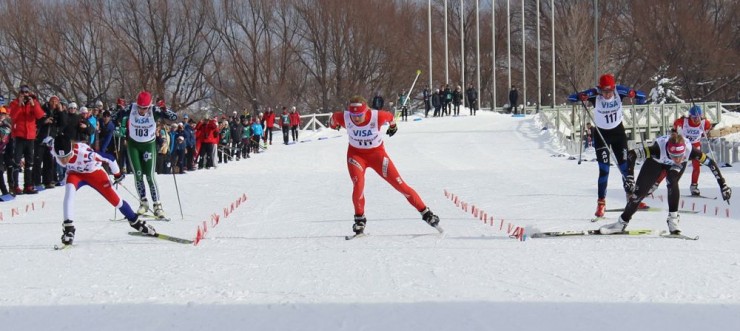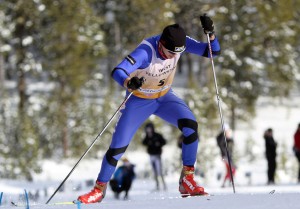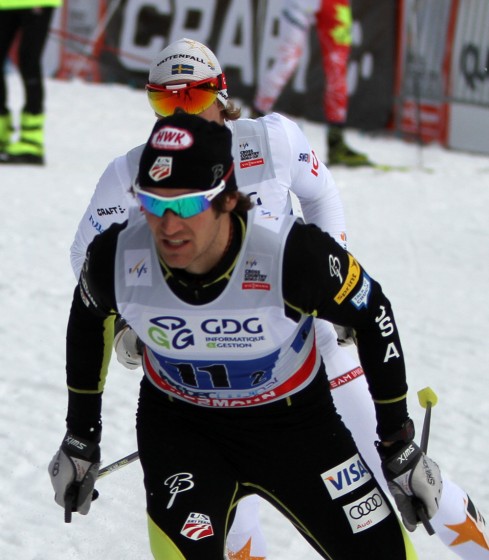Correction: An earlier version of this article incorrectly stated that Torin Koos and Dakota Blackhorse-von Jess had been granted World Cup starts by the US Ski Team. At this point, neither athlete has earned a World Cup start.
The 2014 race season has arrived, and with it, the start of SuperTour racing. The SuperTour is the United States’ Continental Cup series, and is not only the highest level of competition in the country, but also the best way to fast-track to the World Cup.
As usual, the series kicks off in West Yellowstone, Mont., and skiers will be racing towards several different goals. SuperTour rankings and prize money will be on the line, of course, but the SuperTour leaders after the first period of racing will also have the opportunity to race the World Cup races in January. Additionally, for those skiers ‘on the bubble’ of making the Olympic team, the SuperTour races provide valuable chances to lower FIS points.
Olympic team selection will be based on several criteria. Those skiers ranked in the top 50 in the World Cup sprint or distance standings as of January 12 will be named to the team (with a limit of four skiers per gender to be named off of the sprint list). After that, coaches’ discretion kicks in. Skiers not in Europe need to find a way to turn some heads if they are gunning for Sochi.
While racing well domestically certainly doesn’t hurt, the best way to to punch a ticket to the Games is to get to Europe and post strong results against the world’s best, and leading one of the three SuperTour categories at the end of Period I is the best option.

This year’s SuperTour schedule has some significant changes from previous seasons. The Minneapolis, Aspen and Madison SuperTours have been dropped from the schedule, and there will be an inaugural SuperTour weekend in Craftsbury, Vt.
Overall, the number of events has shrunk from nine locations and 24 races to seven locations and 20 races. Additionally, points awarded at the American Birkebeiner will only be half the usual point totals. The idea behind this strategy is to not unduly punish those racers avoiding the long length of the Birkebeiner in order to race optimally in Europe in March.
Key Contenders
The first period of SuperTour racing will have several key players missing. The U.S. Ski Team (USST) will be in Europe, and last year’s SuperTour leaders will be racing the World Cups (with many expenses covered per FIS rules) in an attempt to improve their World Cup rankings and thus the possibility of Olympic Team selection.
These racers include men’s sprint and overall leader Mikey Sinnott, of the Sun Valley Ski Education Foundation (SVSEF), and women’s sprint, distance and overall leader Rosie Brennan, of Alaska Pacific University (APU).
SuperTour distance leader Erik Bjornsen (APU/USST) opted out of those starts in favor of racing stateside. Additionally, Torin Koos, of the Bridger Ski Foundation (BSF) and Dakota Blackhorse-von Jess, of the Bend Endurance Academy (BEA) are in Europe and are hoping to earn World Cup starts rights with strong performances on that side of the pond.
Additionally, longtime SuperTour force Mark Iverson, formerly of APU, has stepped back from elite racing. His former teammate, Brent Knight, continues to represent APU, but is also a member of the Salomon Mountain Running Team, which will be his focus.

Despite these racers missing, the fields will still be plenty deep.
On the women’s side, the veteran trio of APU skiers Kate Fitzgerald, Becca Rorabaugh and Lauren Fritz will all be looking to make an impact. Caitlin Gregg, newly of Loppet Nordic Racing (LNR), Caitlin Patterson, of the Craftsbury Green Racing Project (CGRP), and Jennie Bender (BSF) are all very strong contenders to lead the first period of racing. However, some of the newer skiers to the full-time race circuit will be in the mix.
New and notable skiers to the professional racing scene will be Annie Pokorny (SMST2), who is taking time off from Middlebury College to pursue skiing; Elizabeth Guiney (CGRP), a recent UNH graduate and member of last year’s U23 World Championships team; and Rose Kemp (SVSEF), who joined the Gold Team this year after a strong collegiate career at the University of Utah.
The men’s side will be equally as strong. Look for APU skier Reese Hanneman to lead the pack along with at least three guys from Ski & Snowboard Club Vail/Team HomeGrown: Sylvan Ellefson, Ryan Scott and Tad Elliott. Matt Liebsch (XC United), Brian Gregg (LNR), and Skyler Davis (SMST2) should also be battling at the top of the result sheet.
Notable rookies to the full-time circuit include former collegiate standouts Miles Havlick, a two-time NCAA champion with Utah now with SVSEF, and Sam Tarling, an NCAA champ and Dartmouth grad who joined the Maine Winter Sports Center (MWSC) this year.
While the focus is obviously on the Olympics, no more than a few domestic racers are likely to join the U.S. squad.
Everyone else needs to keep long-term goals in sight. If Period I leaders head to Europe, the doors open for another set of athletes to take over the top spots, and earn their own World Cup experience. This can be critical for long term development, and potential USST nominations.
Holly Brooks (APU/USST) is the best example of a stateside racer leveraging SuperTour success into a World Cup career. After winning the overall SuperTour title in 2011, Brooks, now 31, began the next season in Europe and raced so fast, she not only earned additional start spots, but ended up on the national team.

And while it is only November, the early season SuperTour races often boast the strongest fields this side of SuperTour Finals in March. As the season progresses, and more athletes race overseas or focus their energy on preparing for specific events, the talent in the U.S. can drop somewhat. As a result, racing over the next few weeks should be intense — for the top skiers, there is no time to ease into the season.
Prize money is also not inconsequential for athletes, who are usually operating on a very tight budget. A top placing can cover a good portion of travel costs, and every place makes a difference.
In West Yellowstone, prize money is as follows:
- 1st: $750
- 2nd: $500
- 3rd: $250
- 4th: $200
- 5th: $150
- 6th: $100
U.S. Cross Country Championships in January remain the focus of the domestic calendar, with five events back at Soldier Hollow in Midway, Utah. In addition to both a classic and skate sprint, there will be a 10/15 k classic individual start and a 20/30 k skate mass start.
As usual, the SuperTour wraps up with SuperTour finals, which will be in Anchorage, Alaska. The Finals are coupled with the 30/50 k U.S. Distance Nationals and will feature the return of the relay format.
The Finals will not be a mini-tour, and thus there will be no hill climb, a break from the format initiated in Maine in 2010.
Katie Bono
Katie is a Canadian contributor at FasterSkier. Hailing from Minnesota, she raced for Dartmouth College and Sun Valley before turning her energies to climbing (and becoming the fastest known woman to ascend Mt. Rainier in Washington). Now based in Canmore, Alberta, she is an athlete ambassador for Millet and works as a mountain guide in Alaska, Washington and South America.



